This piece has me scrambling to read the Princess Leia novel & comics before I see The Last Jedi.
Posts in "Long Posts"
Kristen Bell Reunites High School Musical Cast Members for Encore!, Premiering December 10 on ABC | Playbill
Coursework Complete: What Now?
Hi. I’m Kimberly, and I just submitted my last coursework assignment ever (unless I take more after I advance to candidacy, which, let’s face it, is a very real possibility).
I feel like I should rest, but I also feel antsy. So I’m going to make a few public commitments and share a few thoughts about what happens now.
In terms of official officially what’s up…
Now I write a comprehensive literature review on topics related to my area of research interest, which include theory, methodology, and a few different Connected Learning topics. More on that as it proceeds.
Also, I keep working on Project READY.
But also…
I’m planning to publish e-prints of a few annotated bibliographies based on literature reviews I’ve been sitting on. Those literature reviews are the foundation of lots of research ahead of me, and I don’t want to publish my synthesis and analysis, but these are tricky topics where you have to dig into weird places to find literature, and I think it could really help other scholars to get those bibliographies out there. I’m not going to reveal the topics yet because I don’t want to accidentally hint at any conference juries that particular papers are from me.
I’m working with the UNC SILS Coalition of Youth Librarians to start a Triangle area chapter of the Harry Potter Alliance. To that end, I’m going through their Wizard Activist School program.
I’m submitting a proposal to the Connected Learning Summit.
And personally…
I’m going to be packing and purging stuff from my house. We’ve lived in it for five years and there’s definitely stuff that hasn’t been touched in that time.
I’m going to a twentieth anniversary reunion party for The Bronze posting board, the thing that made fandom a social activity for me.
I’m waiting to really dig into cosplay beyond the casual until I can get a good craft studio space set up.
I want to cross-stitch everything from weelittlestitches, but that’s not new.
I want to crochet myself a whole wardrobe of lacy things out of black yarn.
But really, what’s next?
A nap. Christmas decorations. Leonie’s 2018 Shining Year workbook.
Oh yeah, 2018! So that’s going to happen.
Yep. For several years now - probably inspired by Leonie but I’m not sure - I have selected a word of the year. I often find out around March that I picked the wrong word. My 2016 word was FLOW and it turned out perfectly. This year my word was WORK and it was the right word, but it didn’t manifest quite like I expected.
I’ve been searching for 2018’s word. I want to encompass healing, self-care. I had a revelation in the shower yesterday, as I was agonizing over whether my blood sugar would be good when I went to the doctor today (it was; I’m pretty sure that’s thanks to drinking crazy diluted apple cider vinegar, on the advice of the PCOS Diva). Showering and driving, the best activities for having good ideas.
Anyway, this thought came to me:
I want 2018 to be the year when I treat my body with the same care that I treat my mind and my emotions.
Obvi, I’ve invested more energy in my mind than in anything else in my life. And I tend to look after my emotions, and listen to them.
But my poor body. We have been enemies, thanks to chronic illness. I don’t treat it well at all. There are a lot of reasons. I mean, I don’t drink much or do drugs besides those prescribed to me/readily available over the counter. But I also don’t eat nutritious food as much as I’d like or move on the regular or take good care of my skin and hair.
I’m so sorry, body.
So yeah, I’m still working on finding out what word captures that feeling. It’s not HEAL.
I’m leaning toward GLOW right now, but how much that’s influenced by the Netflix series is hard to say. (By the way, Netflix… I need more GLOW merch. kthx.)
It’s what we’ll go with for now.
So, that was really rambly. What’s next, again?
I’m going to glow.
And take a nap.
Free af: A meditation on finishing coursework
It’s a Friday night at 10 pm. My toddler is sleeping beside me. I just spent the past hour browsing conference programs, finding potential colleagues on Twitter, and dipping my toe into the waters of academic Patreon. It’s 10 pm on a Friday and I’m engaging in activities some might classify as work. But to me they feel like play.
I submitted the last of my parental leave work today. I will finish my last bit of coursework next week.
Today I wrote two research prospectuses, both related to game-based learning in libraries. Earlier this week, I planned a partnership to leverage fandom for making the world a better place.
I am done with the tyranny of other people’s syllabi and it feels amazing.
I have had excellent professors who taught excellent courses and I have been either fortunate or strategic about following my interests in fulfilling my assignments. And yet today, when the only work I have to do is the work I have designed (because even my assistantship is something I was part of designing), I feel lighter. Like after two and a half years of getting by, I can finally manage to do the work I started this degree program to do.
I told myself that I would take a true break from work over winter vacation, but now I know that’s not what I want. I want to get moving on this work - work that fills my cup rather than emptying it, work that feels like play, work that keeps me up past my bedtime because I want it to.
I am aware of how academia works. I know this feeling won’t last.
But today… Today I’m filled with excitement about what comes next.
Let's Save the World A Lot: #AASL Fan Activism Workshop Recap
Last Thursday night, I attended the workshop “From Stories to Action: Inspiring Heroes for Our Own World” at the American Association of School Librarians conference. The workshop was presented by Janae Phillips, Director of Leadership & Education for the Harry Potter Alliance. It was the highlight of the conference for me. I left energized and eager to get involved.
The event began with an introduction to HPA - who they are and what they do. Their tagline is “We turn fans into heroes.” Their focus is on fan activism, which they define as “engaging in activism through storytelling and fandom by drawing parallels between popular media and real world social issues.”
 Janae shared her background in leadership development, describing the social change model of leadership development as the model she used:
Janae shared her background in leadership development, describing the social change model of leadership development as the model she used:
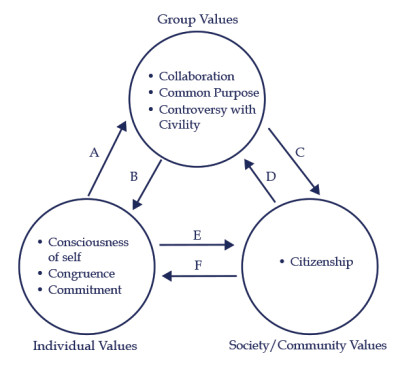
With a quick Google I discovered that this model is commonly used for student leadership development in higher education. If you want to read about it, there’s a lot of scholarly literature out there. From what I can tell, it was first introduced in this book.
Janae then pointed out that most of the stories that inspire modern fandoms hew pretty closely to Joseph Campbell’s Hero’s Journey:
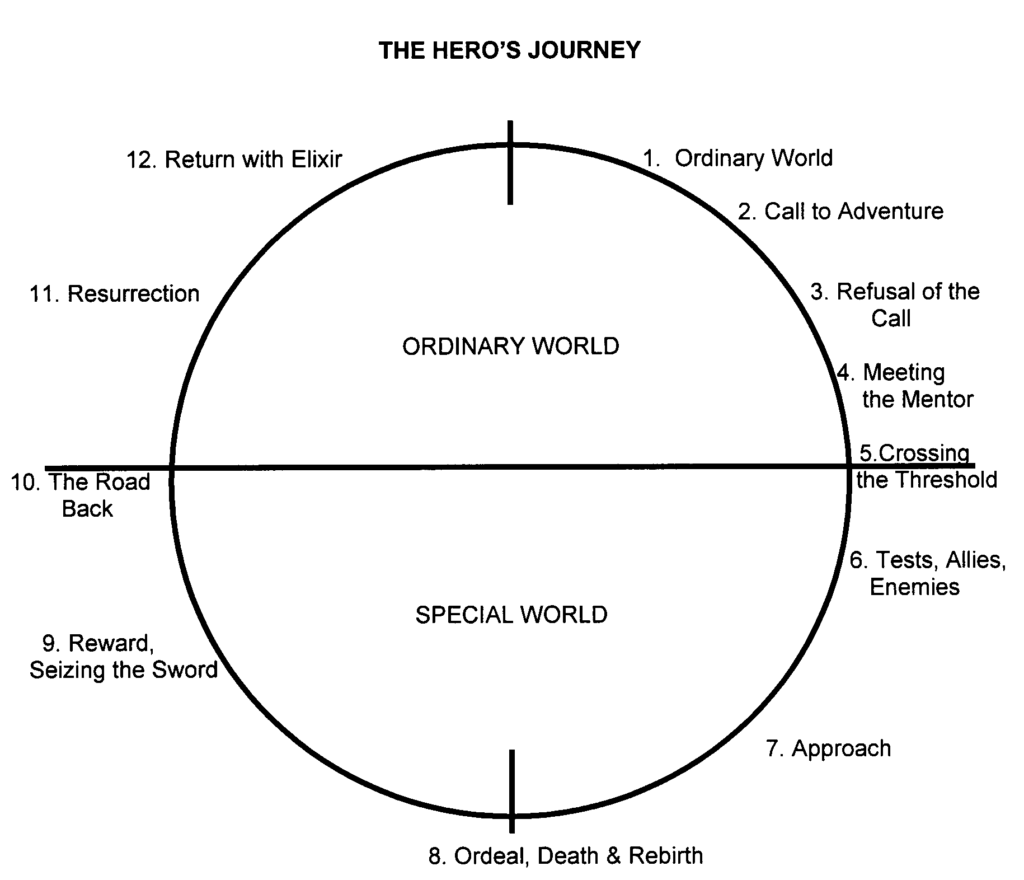
You can read more about this in so many places, but I hear people talk about The Hero with a Thousand Faces the most. I’m ashamed to say I’ve never read it. Maybe I’ll try and squeeze it into my dissertation literature review somehow. (Here’s the part where I admit that this Hero’s Journey aligns closely with Western literature, and naturally has some limitations with respect to its value for analyzing stories cross-culturally.)
Janae introduced the idea that literally overlaying the leadership model on the Hero’s Journey illustrated the promise of using the power of stories to create activist leaders. You can line up the Individual part of the model with the beginning of the journey, see how tests, allies, and enemies might align with group values, and then the Society/Community part aligns with the resurrection and return. (I couldn’t really see if this is how Janae’s version lined up, but I think it probably is.)
Now that we had a theoretical foundation for connecting stories and social change, Janae introduced the innovation adoption curve and discussed the fact that most activist efforts target innovators & early adopters, leaving middle and late adopters out. These individuals - who might be ready to be activists, if they are just introduced to it the right way - can be approached via their own fandoms.
[caption id=“attachment_3288” align=“aligncenter” width=“640”]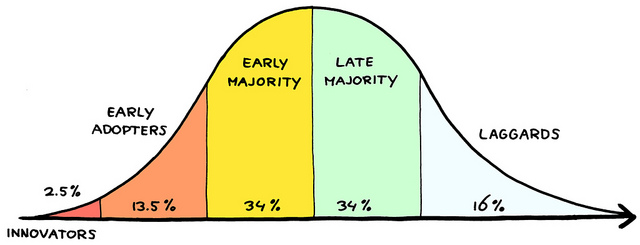 Janae’s version had adorable Harry Potter theming with the Dark Mark over on the Laggards end. I got this version from Jurgen Appelo of management30.com.[/caption]
Janae’s version had adorable Harry Potter theming with the Dark Mark over on the Laggards end. I got this version from Jurgen Appelo of management30.com.[/caption]
She likened middle and late adopters to Neville Longbottom, who at the beginning of the Harry Potter series is overwhelmed and not really sure how to help in the fight against Voldemort, but by the end of the series is protecting the world with as much strength as any of his peers.
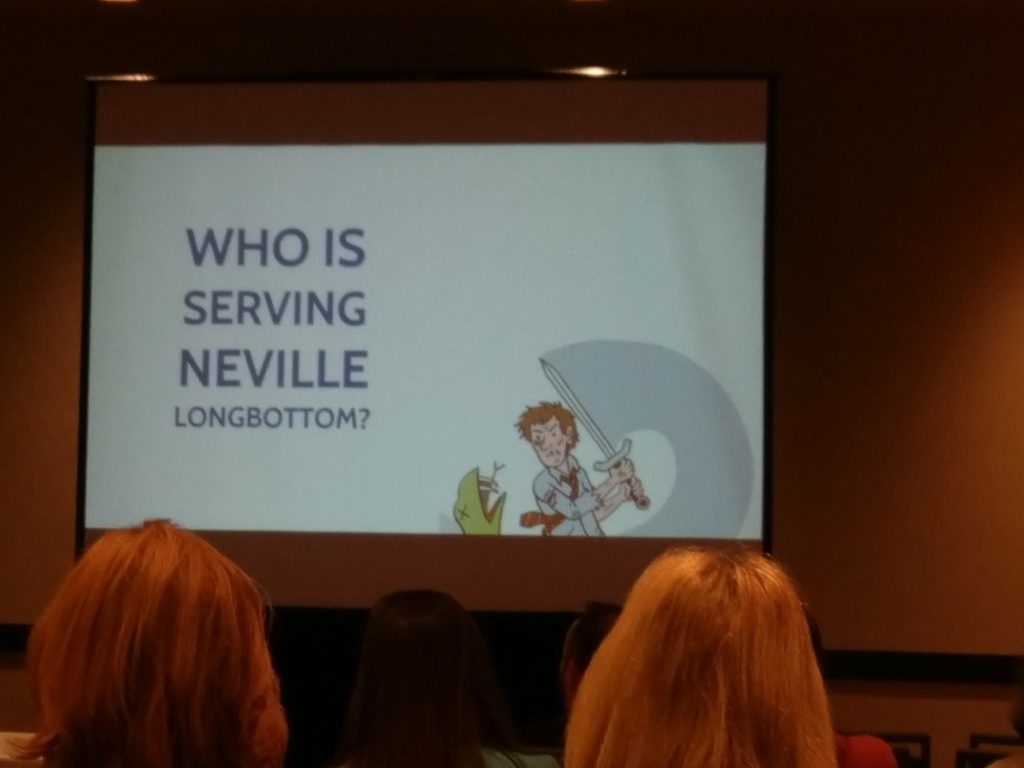
Janae explained that someone who feels they lack the expertise to have a grounded discussion of a social justice issue like racism might be more ready to have that conversation if it is grounded in their own area of expertise - their fandom. She offered here the example of using how Muggle-born and the children of Muggle/Wizard pairings are treated in Harry Potter to get at the idea of racism.
She also pointed out that stories can serve as inspiration for specific actions. For example, in the world of Harry Potter, eating chocolate is an antidote to a dementor attack. Harry Potter-themed chocolate is a real-world product. Janae shared the “Not in Harry’s Name” campaign, in which the HPA lobbied Warner Brothers to ensure all HP-branded chocolate is ethically sourced:
Next up was the workshop part. We divided into groups by fandom (Buffy, Hamilton, Star Wars, HP). First we discussed WHY we loved the texts from these fandoms. THEN we brainstormed possible activist projects that could come out of those. (I was the one who kept calling for a Buffy group, and I got my wish.)
We closed with a sharing, a recap, and information about how we can get involved in the HPA.
Janae finished with a couple of key points that really resonated with me and made me feel energized about my work as a scholar looking at connected learning and culturally sustaining pedagogy, finding ways librarians can leverage youth interests and culture to learn, grow, and make the world a better place.
First, JOY itself is an act of resistance. The bad guys, whomever they may be, want us to be down and defeated. Doing things that make us joyful is part of resisting them.
Second, connecting your activism with something you love gives you the energy to keep going. Social justice work is hard. It’s demanding and exhausting. It’s easy to feel like it’s too hard and we should quit. But if your activism is grounded in a work of art you enjoy and a community of other people who also love that art, that can give you what you need to stick with it.
Finally, I want to close with a question that came up in my group: how do you know which fandom to have motivate activities for the youth you’re serving? The answer, of course, is whichever fandom excites them. You don’t have to know about Dementors or Neville or Muggles or House Elves to find ways to connect Harry Potter to activism, because people who love it, when talking about it, will share with you things that will naturally fit. Let kids share with you what they’re into - find ways for them to bring it in - and as you learn about it, you will find ways to help them think through its connection to the real world and how they can use that to make the world better. To decrease worldsuck, if you will.
5 WAYS TO DISRUPT THE WELLNESS INDUSTRY
This is a great blog post on how to engage in a traditionally exploitative space without feeling gross, i.e., how to transform the space within your sphere of influence.
Where is the Humanity in the Computer Science Curriculum?
Coding is not neutral and neither is cataloging. This is a great argument for requiring computer science professionals to learn about the social impact of their work. I would argue that information and library science should do likewise.
What I'm Learning: Cosplay
This is the start of a new series on What I’m Learning. Interest-driven learning is both my key area of research interest and how most of my hobbies get picked up. I consider myself an expert learner. And I firmly believe that there’s value in sharing the process of the things in which we are experts, in providing models for other people. So I’m going to let you in on the ground floor and give you a perspective on what I’m learning. And we’ll start with something that I’m feeling extra inspired to take up right now: cosplay.
What is cosplay? It’s dressing up in costume as a specific character from media or history. You see it most often at fan conventions. It’s distinct from, though has a lot in common with, any other time you might wear a costume - for Halloween or to perform in a theatrical or dance production, for example.
Why am I getting into cosplay? I have an extensive background of being into costuming. It’s essentially an extension of playing pretend, which is one of my favorite things. My first cosplay (specific media character as opposed to generic idea like “magician”) was my Halloween costume when I was 3 or 4: the Blue Fairy from Pinocchio. My mom is an incredible seamstress, so I often had very detailed costumes growing up.
[caption id=“attachment_3250” align=“aligncenter” width=“300”]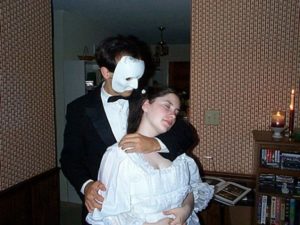 In a detailed replica of Christine’s Phantom of the Opera wedding dress, with my then-boyfriend now-husband, 1999.[/caption]
In a detailed replica of Christine’s Phantom of the Opera wedding dress, with my then-boyfriend now-husband, 1999.[/caption]
I’ve always loved dressing up and, while I don’t care to wear make-up for day to day life, I also really enjoy special effects make-up and hair/wig styling.
[caption id=“attachment_3251” align=“aligncenter” width=“283”] With my sister (right), brother (bottom), and a friend (left) as Cassandra, Rumpleteazer, Skimbleshanks, and Jellylorum from Cats, 1999.[/caption]
With my sister (right), brother (bottom), and a friend (left) as Cassandra, Rumpleteazer, Skimbleshanks, and Jellylorum from Cats, 1999.[/caption]
As a dramatic art major in college, I had to work in the costume shop for a semester. I learned more about make-up and drafting patterns. I also did some sewing and ended up creating a custom-fitted dress that was so detailed in terms of fit that the director the costume shop said I could get into couture.
But you know, life.
Life is crazy and I’m easily overwhelmed, so I haven’t pursued much making my own costumes and accessories or doing hair and make-up. I’ve done some closet cosplay and crocheted accessories, but besides using the hashtag #cosplaygoals to note things I’d be excited to dress up as, I haven’t really engaged.
[caption id=“attachment_3252” align=“aligncenter” width=“225”]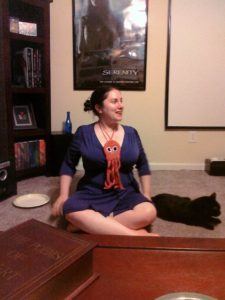 Dressed as a lady from the Fruity Oaty Bars commercial in Serenity. Sitting beside the best cat.[/caption]
Dressed as a lady from the Fruity Oaty Bars commercial in Serenity. Sitting beside the best cat.[/caption]
There’s a whole community around cosplay, but I have only briefly looked into it, admiring others’ work. But it’s time.
Why now? Honestly? Because this article popped across my Twitter feed, and because I’ve been at loose ends waiting for my next hobby to find me. I need something that I can do at home, in small chunks of time, but will eventually have a big payoff. Cosplay fits the bill.
What next? Here are my steps:
- Get inspired. The most inspiring cosplay I've ever seen is this cosplay of Maui from Moana. Not only does it beautifully address issues of representation in terms of both race and body type, it's an example of many different skills that come into play: materials selection, inking, wig styling, jewelry creation, prop creation, programming, wiring. This quote kind of sums it all up:
"Cosplay is a blend of science and art, and being able to develop my craftsmanship skills and partner them with my performance abilities creates a magical experience. I thrive in these little pockets of shared sunshine where we can step outside of our ordinary lives and create the world we've imagined.
- Start reading. My earliest step when learning anything new is to research it pretty deeply. The SLJ article I linked above provides a few good places to start, so I'm starting with those, beginning with The Hero's Closet: Sewing for Cosplay and Costuming. If reading isn't how you like to learn things, the post includes some great videos. You can also seek out expert cosplayers and find out what they have to share. The names of several are mentioned in the SLJ article.
- Attend an event. I'm very lucky that Cosplay America is happening this weekend essentially in my backyard. With a toddler in tow and my husband out of town, I can't really swing a full three-day convention, but I'll be going on Sunday.
- Recruit a partner-in-crime. This kind of thing is always more fun when it's social. I think I've gotten both of my siblings on board with digging deeper into cosplay, though I'll be taking the lead. My brother will be joining me at Cosplay America.
[caption id=“attachment_3253” align=“aligncenter” width=“225”]
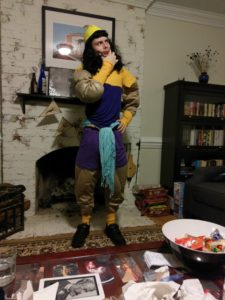 My brother as Kronk from The Emperor’s New Groove.[/caption]
My brother as Kronk from The Emperor’s New Groove.[/caption] - Make a plan. I don’t have a lot of great costumes on hand right now, so I’ll be closet cosplaying as Wednesday Addams at Cosplay America. If I can find suitable clothing for the toddler, he’ll be going as Pubert.
[caption id=“attachment_3254” align=“aligncenter” width=“184”]
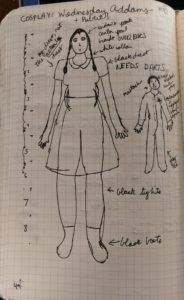 Notes in my Bullet Journal about my Wednesday closet Cosplay Plans.[/caption]
Notes in my Bullet Journal about my Wednesday closet Cosplay Plans.[/caption]
So that’s where I’m starting. Stay tuned for updates!
Current Desktop
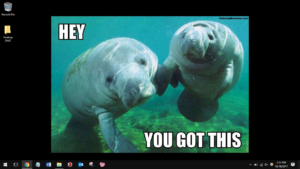
Inspirational Research: Improvising our Way through Tragedy: How an Improv Comedy Community Heals itself through Improvisation
It can be easy when you’re immersed in academia to kind of forget what the point is. I’m starting a series where I write about scholarship that I’ve found inspiring. Today I’m starting with Jason Scott Quinn’s Improvising our Way through Tragedy: How an Improv Comedy Community Heals itself through Improvisation.
Why did I read this?
I’m (still) working on a study I started a year ago as a project for my Advanced Qualitative Methods class. Sadly, I didn’t go through IRB, so I can’t publish anything from the study. I’ll just say that I am looking at how learning happens in the context of an improv team, specifically a team that performs the Harold. I picked this site not because it’s key to my research interests (though I can certainly argue that improv is a fruitful environment for connected learning), but because I knew it would be easy to get access.
As a smaller assignment leading up to the full report on the study, I’m doing a small literature review. I’m specifically looking at studies on improv comedy with an eye to their conceptual frameworks, use of theory, and audience. I came across this article in the course of doing my literature search for this lit review.
What’s so inspiring about it?
Content: This is an article about how the NYC improv community used dialogue and performance to heal after 9/11. I mean, that right there pushes a ton of my inspiration buttons. Anything that brings together community, healing, and performance is going to tug at my heartstrings. Also, it’s about improv, and while I’m taking a break of indeterminate length from performing and watching improv due to early parenthood and some other stuff, I still find improv fascinating.
Methodology: This is a qualitative study using autoethnography. Before I started this project, I wasn’t sure about autoethnography. I thought it sounded self-indulgent. But as I’ve gone through the process of collecting data and reflecting on my own experiences with improv, as well as my experiences with other communities, I’m really beginning to see the value of research that connects the personal to the broader world.
Presentation: This is what really makes this an inspirational piece for me, though. The results of this study are presented as a performance piece. This piece integrates quotes from message board postings, monologues, and improvisational performance. It provides an excellent model for me of how to use this kind of representation. It’s something that the assigned readings for my qual methods class touched on, but it offers a model that speaks very directly to my interests. Sadly, my final presentation for the class will have to be fully digital and thus won’t incorporate improv like this piece did. I wish it could, though, and this has been really helpful in thinking about how, if I ever do research on improv in the future, I might represent those results.
Should I read this?
If you’re interested in how improvisation can be a part of research presentations, absolutely. Also if you just like to read about improv, yes. Quinn’s language is accessible and will introduce you to some interesting theory you might not already know.
